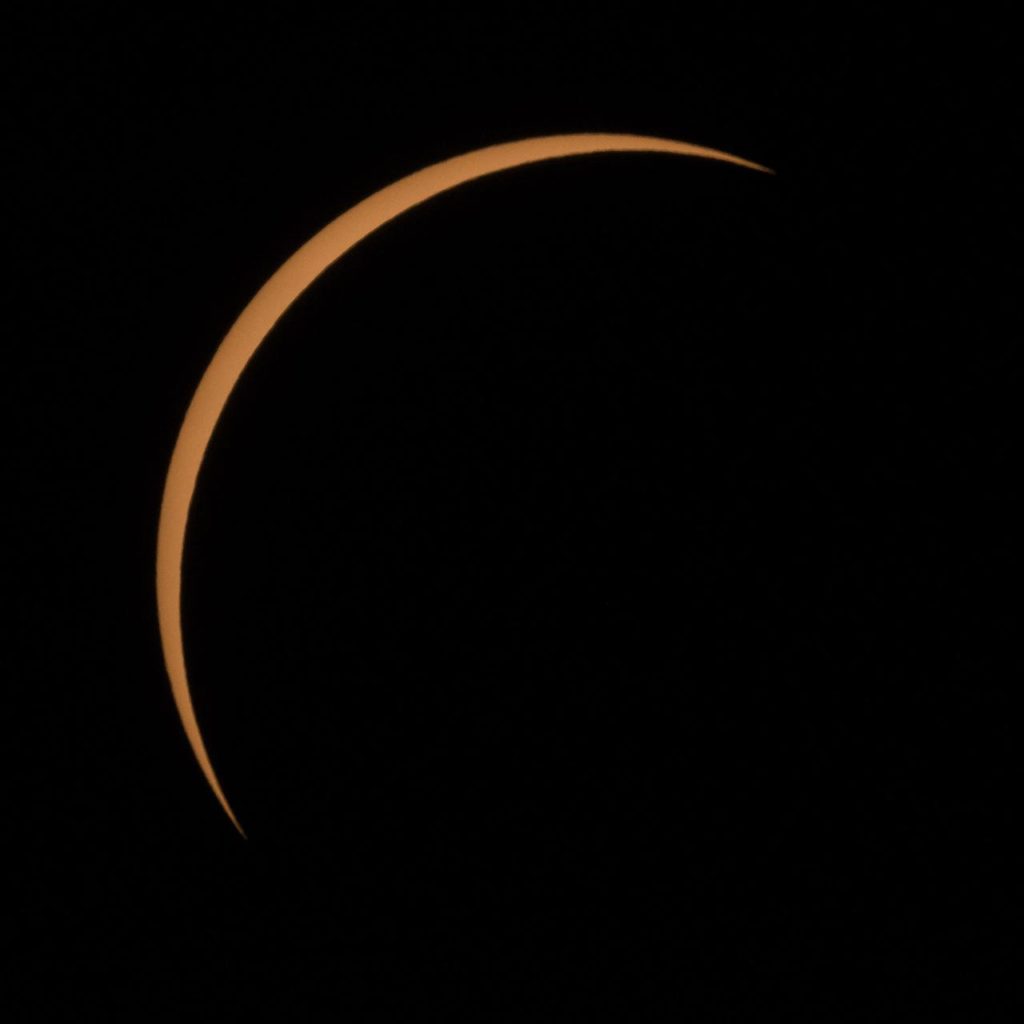Editor’s Note: The Total Solar Eclipse is emerging over Texas and HMNS Astronomer James Wooten is giving us the details down to the minute.
Jupiter is low in the west at nightfall. No star at night is as bright. Watch as Jupiter appears slightly lower in the sky each April evening until it sets in twilight by April 30.
Mars and Saturn are low to the east-southeast horizon at dawn. They are about six degrees apart as April begins. However, Mars is closing on Saturn’s position, until the two planets are about half a degree apart on the morning of the 10th. Having overtaken Saturn, Mars pulls away each morning after that. During April, Mars and Saturn appear slightly farther from the Sun, and thus slightly higher in the morning sky, each morning.
Venus is lost in the Sun’s glare and out of sight this month.

We have a new visitor in the skies this month—Comet Pons-Brooks! This comet, nicknamed the ‘Devil Comet’ because it seemed to have two ‘horns’ last December, returns to our part of the solar system every 71 years. It is now in the west at dusk, brightening day by day as it approaches perihelion (nearest approach to the Sun) on April 21. Pons-Brooks is already bright enough to be visible in binoculars; it may even become visible to the unaided eye in dark skies (far from any city and without twilight). Pons-Brooks is closest to Earth on June 2, but by then its position will be south of the equator and thus hard for us to observe. Early April 2024 is thus our best time to see it. Here are some sites to help you:
https://www.heavens-above.com/comet.aspx?cid=12P&lat=0&lng=0&loc=Unspecified&alt=0&tz=UCT
https://www.skyatnightmagazine.com/advice/comet-12p-pons-brooks-april-2024
April is the last month to see the full set of brilliant winter stars which now fill the western evening sky. Dazzling Orion is in the southwest at dusk. His three-starred belt is halfway between reddish Betelgeuse and bluish Rigel. Orion’s belt points rightward to Aldebaran in Taurus the Bull. To Orion’s upper left are the twin stars Castor and Pollux, marking the heads of Gemini, the Twins. You can find Sirius, the brightest star we ever see at night, by drawing a line from Orion’s belt towards the left. Forming a triangle with Sirius and Betelgeuse is Procyon, the Little Dog Star.
Joining the winter stars are stars of spring rising in the east. Ursa Major, the Great Bear, which includes the Big Dipper, is high above the North Star on spring evenings. Extend the Big Dipper’s handle to ‘Arc to Arcturus’ and then ‘speed on to Spica’. Look for Leo, the Lion high in the sky at dusk. There are fewer bright stars in this direction because of where the plane of our galaxy is in the sky. The area of sky between Gemini and Taurus and over Orion’s head is the galactic anticenter, which means that we face directly away from the galactic center when we look in this direction. Those bright winter stars setting in the west are the stars in our galactic arm, right behind the Sun. On the other hand, if you look at the sky between Ursa Major, Leo, Virgo, and Boötes, you’re looking straight up out of the galactic plane, toward the galactic pole. There are fewer bright stars in this direction.

Moon Phases in April 2024
Last Quarter Apr. 1, 10:30 p.m.
New Apr. 8, 1:21 p.m.
1st Quarter Apr. 15, 2:13 p.m.
Full Apr. 23, 6:49 p.m.
The New Moon of April 8 casts its shadow onto the Earth, causing a total solar eclipse. What’s more, the Moon’s shadow actually crosses the center of the USA, including Texas! Houston is not quite in the path, so we’ll see the Moon cover 94% of the Sun. The partial eclipse starts at 12:20 pm. Maximum eclipse (94% coverage) is at 1:40 pm and the eclipse ends at 3:01 pm. You can experience this eclipse with us at our main location in Hermann Park or at our campus in Sugar Land. Even if it is overcast, notice how much darker the sky becomes near maximum eclipse at 1:40.
The same New Moon marks the end of Ramadan. Islamic months can’t begin until someone sees the slim crescent. This will probably be April 9, making April 10 the first day of Shawwal (the month after Ramadan). Muslims celebrate this as Eid al-Fitr.
Our George Observatory is now open every Saturday night for observing! Purchase tickets in advance on our website.
Clear Skies!
Read more about the Total Solar Eclipse here.






